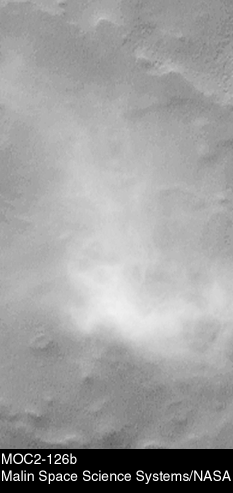
Mars Global Surveyor
Mars Orbiter Camera
South Melea Planum, By The Dawn's Early Light
MGS MOC Release No. MOC2-126, 11 May 1999


MOC "sees" by the dawn's early light! These two pictures were
taken over the high southern polar latitudes during the first week of May
1999. The areas shown are currently in southern winter darkness. Because
sunlight is scattered over the horizon by aerosols--dust and ice
particles--suspended in the atmosphere, sufficient light reaches regions
within a few degrees of the terminator (the line dividing night and
day) to be visible to the Mars Global Surveyor Mars Orbiter Camera (MOC)
when the maximum exposure settings are used.
The picture on the left (MOC2-126a) shows a polygonally-patterned surface
on southern Malea Planum. At the time the picture was taken, the sun was
more than 4.5° below the northern horizon. The scene covers an area
3 kilometers (1.9 miles) wide, with the illumination from the top of the
picture.
The image on the right (MOC2-126b) shows a bright, wispy cloud hanging
over southern Malea Planum. This cloud would not normally be visible, since
it is currently in darkness. At the time this picture was taken, the sun
was more than 5.7° below the northern horizon. The scene covers an area
3 kilometers (1.9 miles) wide. Again, the illumination is from the top.
In both frames, the surface appears a relatively uniform gray. At the
time the pictures were acquired, the surfaces were covered with south polar
wintertime frost. The highly reflective frost, in fact, may have contributed
to the increased visibility of these surfaces.
This "twilight imaging" technique for viewing Mars can only
work near the terminator; thus in early May only regions between about 67°S
and 74°S were visible in twilight images in the southern hemisphere,
and a similar narrow latitude range could be imaged in the northern hemisphere.
MOC cannot "see" in the total darkness of full-borne night.
Malin Space Science Systems and the California Institute of Technology
built the MOC using spare hardware from the Mars Observer mission. MSSS
operates the camera from its facilities in San Diego, CA. The Jet Propulsion
Laboratory's Mars Surveyor Operations Project operates the Mars Global Surveyor
spacecraft with its industrial partner, Lockheed Martin Astronautics, from
facilities in Pasadena, CA and Denver, CO.
 To MSSS Home Page
To MSSS Home Page
Contact: info@msss.com

